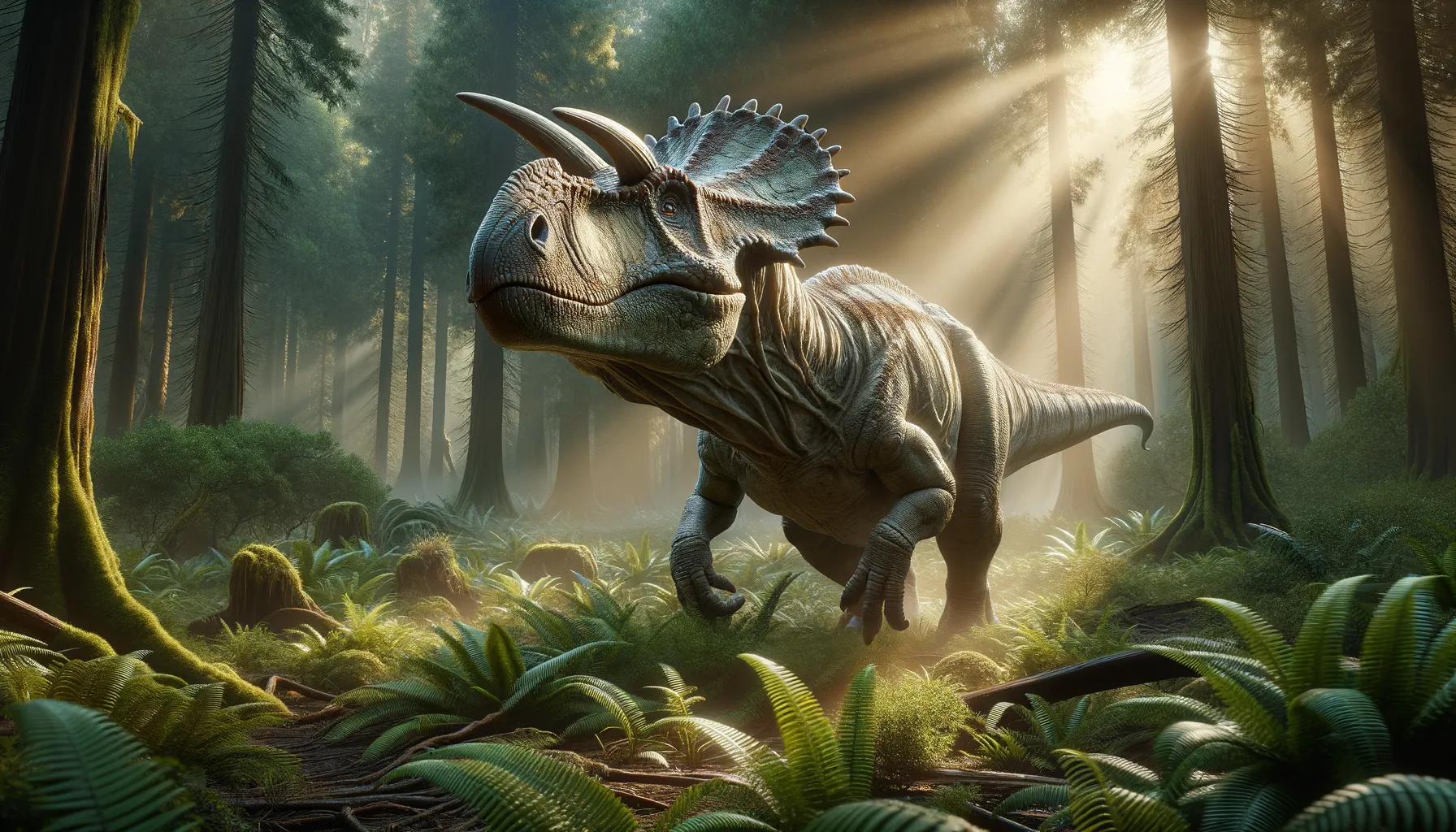
Einiosaurus
Horned survivor of the Cretaceous plains.
Period
Cretaceous
Length
Measured approximately 14 to 20 feet long.
Height
Stood about 6 to 8 feet tall at the hips.
Weight
Weighed around 1.3 to 2 tons.
Einiosaurus, known for its distinctive forward-curving nose horn, was a ceratopsian dinosaur that thrived during the Late Cretaceous period. As a herbivore, Einiosaurus roamed in herds across the lush landscapes that are now part of North America. Its unique cranial ornamentation and frilled skull have made it a subject of significant interest to paleontologists, offering insights into the diversity of ceratopsian dinosaurs and their evolutionary developments.
Diet
Einiosaurus was an herbivore, primarily feeding on low-growing vegetation. It likely used its beak to clip plants and consume ferns, cycads, and conifers.
Hunting
As an herbivore, Einiosaurus did not hunt for food. Instead, it grazed in herds, likely aiding each other in finding sufficient plant matter for their large sizes.
Environmental challenges
Einiosaurus faced environmental challenges such as seasonal changes that affected food availability. Predators like large theropods also posed consistent threats, prompting the development of defensive features like horns. Periodic droughts could have significantly affected their habitat, driving migration patterns to find water. Competition with other herbivores for food resources was another challenge in their ecosystem.
Speed
It moved relatively slowly as it was a heavy, herbivorous dinosaur.
Lifespan
Approximately 10 to 20 years in the wild.
First discovery
Einiosaurus fossils were first discovered in Montana, USA, in the 1980s.
Fun Facts
- Einiosaurus means 'buffalo lizard' and it had a horn that curled forward like a banana.
- It lived around 75 million years ago during the Late Cretaceous period in what is now Montana, USA.
- Einiosaurus belonged to a group of dinosaurs called ceratopsians, which were known for their large frills and horns.
- Unlike some of its ceratopsian relatives, Einiosaurus's horn was unique for its downward curve.
- Einiosaurus traveled in herds, which helped protect them from predators.
- These dinosaurs were herbivores, primarily feeding on ferns, cycads, and conifers.
- Einiosaurus fossils have provided scientists with valuable information on how ceratopsian dinosaurs grew and developed.
Growth and Development
Einiosaurus likely went through several stages of growth, starting with small hatchlings that grew rapidly to avoid predation. Juveniles might have joined herds early for protection and social learning. This species developed its characteristic nose horn as it matured, which could have played roles in defense and social interactions. Bone histology studies suggest a relatively quick growth rate compared to other dinosaurs.
Habitat
Einiosaurus inhabited floodplains and river valleys of what is now North America. These areas provided abundant plant life, crucial for their herbivorous diet. The moist, lush environment supported a variety of plant species suitable for grazing. Seasonal changes could affect the ecosystem, requiring Einiosaurus to migrate or adapt to shifting resources.
Interaction with other species
Einiosaurus likely interacted with other herbivorous dinosaurs, sometimes competing for the same food sources. It coexisted with theropods, which were natural predators, pressuring Einiosaurus to develop herd behaviors. Symbiotic relationships with small mammals or insects might have existed, aiding in seed dispersal. Social structures within its own species would have been important for defense against predators.
Natural lifespan
Its natural lifespan possibly ranged between 10 to 20 years.
Reproduction
Einiosaurus reproduced by laying eggs in nests, likely communal ones for increased survival rates. Its young were thought to be altricial, requiring care from adults until they could fend for themselves. Herding behavior might have helped protect nests from predators. Skelatal growth studies suggest rapid juvenile development, possibly as a survival strategy.
Social behaviour
Einiosaurus is thought to have been a social species, living in herds that offered protection from predators. These herds could have also facilitated communication through visual displays using their notable horns and frills. Social hierarchies might have been established within groups, particularly among males for mating rights. Group movement would aid in resource location and defense.
Fossil locations
Einiosaurus fossils have primarily been found in Montana, USA. The excavation sites have provided numerous well-preserved skulls and skeleton materials. These discoveries have been instrumental in reconstructing their physical appearance and understanding their lifestyle. Fossil finds have allowed scientists to study the growth patterns and population dynamics of Einiosaurus.
